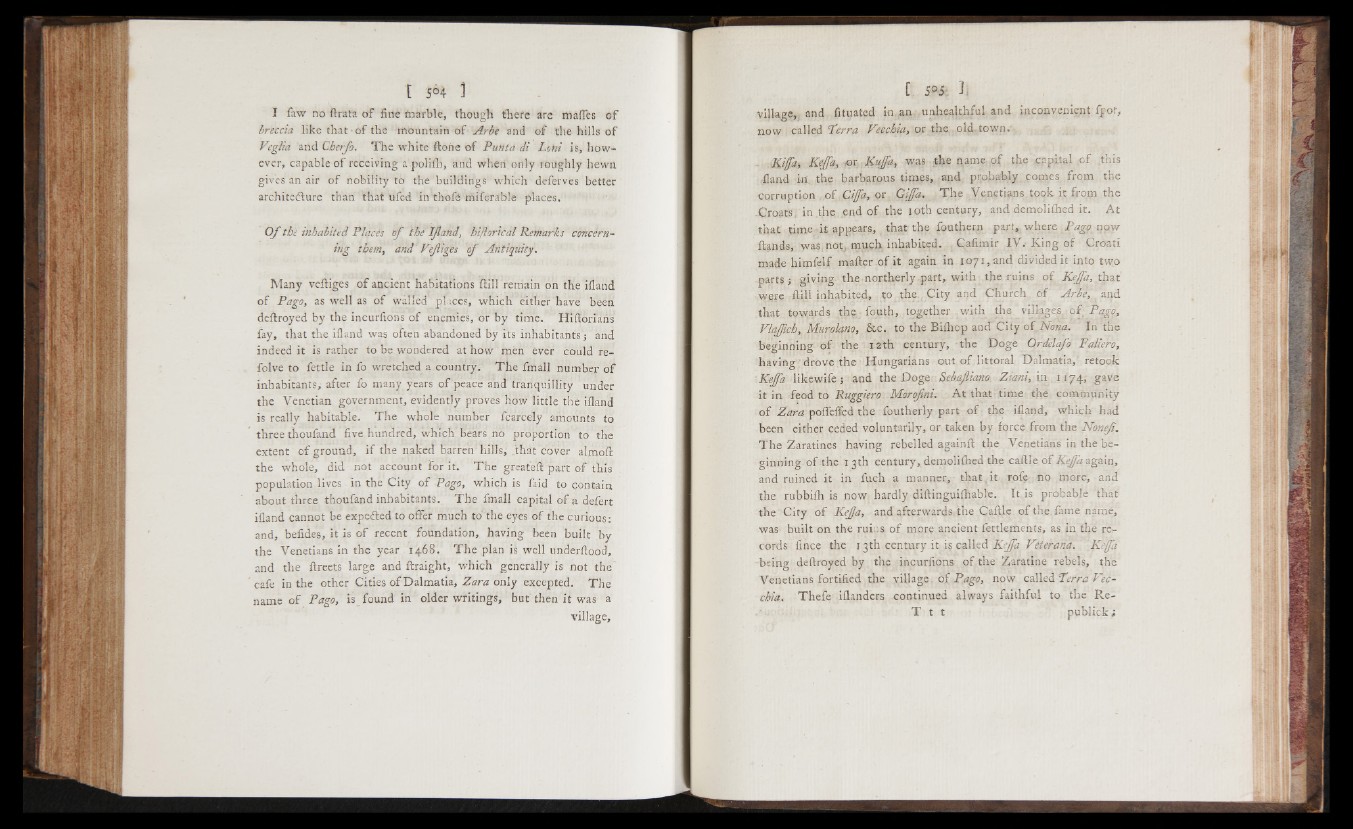
ï faw no ft rata of finé fnarble, though there are mafles o f
breccia like that • o f the mountain of Arbe and of the hills o f
Vcglia and Gherfo. The white ftone o f Punta di Lohi is, however,
capable of receiving a .polifh, and when only roughly hewn
gives an air o f nobility to the buildings which deferves better
architecture than that ufed in thofé miferable places.
O f the inhabited Placés o f the IJtand, hiflorical Remarks concerning
them, and Vejliges o f Antiquity.
Many veiliges o f ancient habitations ftill remain on the ifland
of Pago, as well as o f walled' places, which’ either have been
deftroyed by the incurfions of enemies, or by time. Hiftorians
fay, that the ifland was often abandoned by its inhabitants’; and
indeed it is rather to be wondered at how men ever could re-
folve to fettle in fo wretched a country. The fmall number o f
inhabitants, after fo many years o f peace and tranquillity under
the Venetian government, evidently proves how little the ifland
is really habitable. The whole number fcarcely amounts to
three thoufand five hundred, which Bears no proportion to the
extent o f ground, i f the naked Barren hills,' .'that cover almoft
the whole, did not account for it. The greateft part o f this
population lives in the City o f Pago, which is faid to contain
about three thoufand inhabitants. The fmall capital o f a defert
ifland cannot be expeited to offer much to the eyes o f the curious:
and, beiides, it is of recent foundation, having been built by
the Venetians in the year 1468. The plan is well underflood,
and the ftreets large and ftraight, which generally is not the
cafe in the other Cities of Dalmatia, Zara only excepted. The
name o f Pago, is found in older writings, but then it was a
village,
village,, and fituated in, an unhealthful and inconvenient fpot,
now called ferra Vecchia, or the old town.
. diifa-, Kejfa, or Kujfa, was the name, o f the capital o f this
Hand in, the barbarous times, and probably comes from the
corruption .o f Cijfa, or Gijfa. T he Venetians took it from the
Croats, in .the end o f the 10th century, and demoiifhed it. At
that time-it appears, that the fouthern part, where Pago now
ftands, was not, much inhabited. , Cafimir IV . King of Croati
made himfelf mafter o f it again in 1071, and divided it into two
parts; giving- the northerly.part, with the ruins o f Kejfa, that
W,ere ftill inhabited, to the . City and Church of Arbe, and
that toyyards the fouth, together with the villages.:o f Pago,
VlaJJich, Murolano, & c . to the Biftiop and"City of Nona. In the
beginning o f the 12th century, the Doge Ordelafo Faliero,
having drove the Hungarians out o f littoral Dalmatia/retook
Kejfa like wife ; and the Doge Sebajliano Ziani, in 1 i 74, gave
it in feod to Ruggiero Morofni. At that time the community
o f Zara pofleffed the foutherly part o f the ifland, which had
been either ceded voluntarily, or taken by force from the Noneji.
The Zaratines having rebelled againft the Venetians in the beginning
o f the 13 th century, demoiifhed the caftle o f Kejfa again,
and ruined it in fuch a manner, that .it rofe no more, and
the rubbifh is now hardly diftinguifhable. It is probable that
the City o f Kejja, and afterwards the Caftle o f the, fame name,
was built on the ruins o f more ancient fettlements, as in the records
fince the 1 3th century it is called Kejfa Veterana. Kejfa
being deftroyed by the incurfions of the Zaratine rebels, the
Venetians fortified the village of Pago, now called Terra Vecchia.
Thefe iflanders continued always faithful to the Re-
T t t publick;